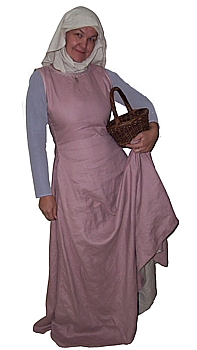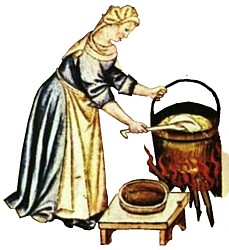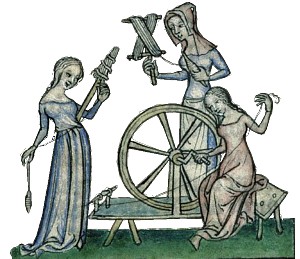|

Medieval
Rural & Peasant Women at Home
COOKING - CLEANING
- SHOPPING - GARDENING - LIVESTOCK & POULTRY
 Medieval
rural and peasant women almost always worked a few days a week
for their lord- often in the fields beside their men. Here we
will look at what they did in their own homes. Even today, the
working mother still has domestic duties waiting for her when
she gets home from work! Medieval
rural and peasant women almost always worked a few days a week
for their lord- often in the fields beside their men. Here we
will look at what they did in their own homes. Even today, the
working mother still has domestic duties waiting for her when
she gets home from work!
Cooking
Generally, the rural medieval woman made and cooked her own food
for herself and her family, whether that be her husband and children
or as part of her own family while growing up.
Food choices may have been simpler than women living in towns,
but by no means was it bad. Fresh herbs and home-grown produce
today are preferred to the stored, processed food of major supermarket
chains where food has been transported long distances. Young girls
learned cooking from their mothers and women served meals at their
own family tables.
Kitchen implements may have been quite basic- an iron pot, wooden
spoons, a trivet, knives, but all quite functional and there is
no reason to believe that these things were in poor condition.
A woman who has less to spend on replacing her kitchen things
was more likely to take good care of the belongings.
 Often
we hear that a family may have had nothing but bread and cheese
for their supper but consider homemade herb cheese with fresh
baked bread and the picture is perhaps not so dim as it sounds.
Of course, in times of little where a stew has been "extended"
a few days, the food was not always the best. In times of hardship,
bread and cheese may have been old. Often
we hear that a family may have had nothing but bread and cheese
for their supper but consider homemade herb cheese with fresh
baked bread and the picture is perhaps not so dim as it sounds.
Of course, in times of little where a stew has been "extended"
a few days, the food was not always the best. In times of hardship,
bread and cheese may have been old.
Many dishes used milk and eggs, and since a rural family was likely
to have a cow or goat or sheep for milk and chickens for eggs,
this was able to be a staple in their diets. Bees provided honey
for sweetening.
Vegetables were seasonable and fresh fish may have been available
from streams.
 Meat
itself did not play a huge part in the rural family's diet. Consider,
if you kill the chicken or the sheep, you are killing your source
of eggs, wool and milk- all precious resources for a family with
little. Meat
itself did not play a huge part in the rural family's diet. Consider,
if you kill the chicken or the sheep, you are killing your source
of eggs, wool and milk- all precious resources for a family with
little.
The modern picture of lamb
shanks as a staple medieval food does not take this into consideration
for the poorer family with limited livestock and a need for milk,
wool, butter.
A woman made her own butter and cheese, bread and ale, but could
possibly buy ale and bread. Making ale took a great deal of time
which the busy woman did not have time for herself.
Bread might also be baked
in a communal oven, and in many cases, housewives were obliged
to not only grind the grain at the manor mill instead of grinding
her own at home, but to pay for the use of it as well.
At home, it was the woman's duty to tend the fire and be responsible
for keeping it alive.

Cleaning
and housework
Rural woman did their own cleaning, although many peasant women
had domestic help. It isn't true that all peasants were extremely
poor, and a young, unmarried woman could earn extra money working
in another home. In her own house, she had dishes from cooking
and eating to tend to, laundry of clothes and bedsheets, bedbugs
and household pests to deal with and floors to sweep.
Washing clothes may have been done either inside over a fire or
at a nearby stream and was often a social occasion as well as
a necessary chore. Laundry seems to be an exclusively female activity.

Spinning
and weaving
 Most
rural women engaged in spinning and weaving. This provided fabric
for their own use for clothes and bedding and also spun wool could
be sold on to merchants in towns providing extra income for the
household. Most
rural women engaged in spinning and weaving. This provided fabric
for their own use for clothes and bedding and also spun wool could
be sold on to merchants in towns providing extra income for the
household.
Even a young girl could be taught how to use a spindle and how
to prepare wool for spinning. By the time a young woman was in
her late teens, she was already an accomplished spinner. Her threads
would have been even and of a reasonably high quality. By the
time she was married and making clothes for her own family, the
cloth she produced would have been of quite a good standard.
The clothes made from them
were unlikely to be coarsely woven and chunky as we see in medieval
movies. Years of practice means even a poor woman was able to
produce a good result.
She required no special tools that her counterparts in the cities
had- it came down to her individual ability and experience. We
often see manuscript pictures showing a woman going about her
farm duties with a spindle to spin in her spare moments.

Shopping
Shopping took two forms- going to market to sell and buy wares
and that of the traveling peddler. Most nearby towns had a regular
weekly market where rural people would come for the day and sell
their home produce and buy from butchers and bakers.
Traveling peddlers provided brought items which were harder to
get locally or specialty items.

Gardening
Generally, it was accepted that men did the heavy work and women
tended the vegetable gardens, weeding and looking after the small
crops and herbs for the family use.
Many women used herbal remedies
in their personal toilette and made scented washes for their face
and hair. Herbs were also grown for cooking.
Manuscripts like the 14th
century English Luttrell Psalter also show women engaged
in garden work alongside men.

 Livestock
& Poultry Livestock
& Poultry
A rural woman would have had the opportunity to keep chickens,
ducks, geese as well as perhaps a goat or cows for cheese and
milk. The milking and care of these fell soeley on the shoulders
of the woman of the household. She taught her daughters, who would,
in turn, teach theirs.
Living in the country provided grazing and space to keep poultry
which a townswoman would not have had.
She would also have been responsible for shearing sheep and milking
cows
Horses, if they were owned by the family, would be looked after
by the menfolk.

Raising
Children
A peasant or rural woman was responsible for raising her own children.
This took place the same way that it does today with stay-at-home
mothers who work from home while they bring up their children,
teaching them skills they need later in life- cooking, cleaning
etc.
Babies are usually shown in their cradles swaddled and at that
stage would have been little hindrance to their mother's daily
duties. Once they became toddlers, they shadowed their mothers
exactly the same way they do today.
A young boy, once reaching a certain age, would accompany his
father to work in the fields or learn the basics of a trade before
becoming old enough to start work alongside his father or become
apprenticed to a trade. A young girl would help her mother in
the house and in the garden learning all the domestic things she
would need to know when she became a wife and mother herself.

Copyright
© Rosalie Gilbert
All text & photographs within this site are the property of
Rosalie Gilbert unless stated.
Art & artifact images remain the property of the owner.
Images and text may not be copied and used without permission.
|